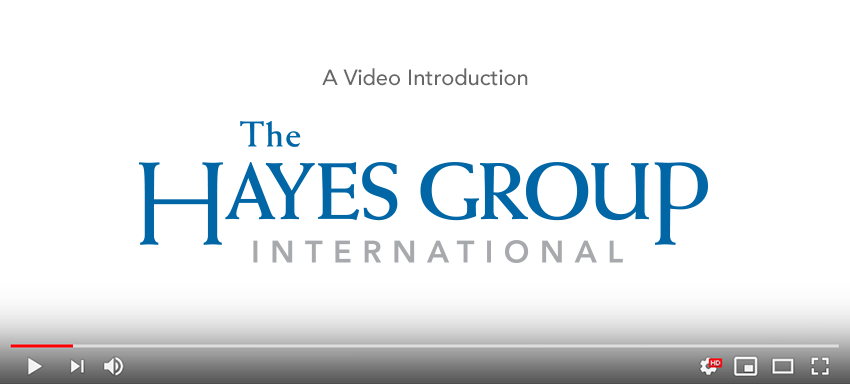The Power of Perception

Essay by Walker Armstrong, Senior Consultant at The Hayes Group International
Have you ever met a leader who just doesn’t get it? I am not talking about someone who lacks talent, is lazy or doesn’t have the intellectual horsepower to fulfill the requirements of their job. I am referring to someone who seems disconnected from the people they lead. They can be very competent or perhaps even brilliant at their profession, but when it comes to understanding what is really going on with their folks they seem clueless. This gap of insight always creates problems in organizations and eventually can derail a leader in their career.
The solution is not to boost the leader’s IQ but to enhance their EQ. What is EQ you might ask? Over the last twenty years neuroscientists and psychologists have uncovered amazing aspects of how our brains work, particularly in the ways emotions blend with cognition to build our viewpoints and create our ideas of the world around us. From a leadership perspective EQ (or Emotional Intelligence) can be basically defined as understanding our own emotions, using those emotions as positive energy to get things done, properly identifying the emotions of others, and leveraging what is most important to others to accomplish organizational goals. This essay focuses on the third component or what some might call perception.
The ways in which the brain identifies, categorizes, interprets, and acts on the emotions of others is a complex series of exchanges between its upper and lower regions. The lower regions are primarily responsible for fast and efficient identification while the upper regions or cortices are involved in both accurately determining what these emotions mean and then acting on what is perceived. This synchronistic switching back and forth between the upper and lower parts of the brain enables us to both recognize and respond in a holistic manner to the emotions of others. For our discussion, we will hone in on the three capacities of facial recognition, deep listening and social cognition that fit into the category of perception, or what Daniel Goleman refers to in his book Social Intelligence as social awareness.
To diagnose why a leader doesn’t “get it,” we might first see if they are paying attention to the meta-narratives of facial expressions. Apart from injury to visual memory or cognition areas the average brain contains mirror neurons that are engaged once there is the awareness of another’s actions. Goleman refers to these specialized brain cells as a kind of “neural Wi-Fi” which enables us to simulate what others are feeling. Neuroscientists call this phenomenon “empathic resonance” meaning that we have the ability to be virtually linked to another person.
Despite this inbuilt aptitude to read people, many of us have a hard time rightly ascertaining what we are seeing. Why? Because many of the emotions expressed by others are often layered or even slightly hidden to the casual observer. World-renowned researcher Paul Ekman is quite familiar with this occurrence. He has spent a lifetime cataloguing all of the types of potential expressions the one-hundred and nighty-eight facial muscles can make. For instance, he has catalogued eighteen different types of smiles. His training on face-recognition has been used by law enforcement agencies for years with great results. For those who don’t have the time for such extensive and expensive training there are many facial recognition exercises one can do that can improve accurately assessing the emotions of others.
Another way we can get better at understanding the subtleties of facial recognition is by becoming more aware of how we are presenting ourselves to others. For over forty years The Hayes Group International has videotaped thousands of individuals from all walks of life who are seeking to enhance their own coaching and influence skills. A common occurrence in these sessions is the shock people have when they see themselves on tape. Whether they look stern or nervous the participant is sometimes taken aback at what they see. It provides an incredible learning opportunity because they can take responsibility for these expressions in a way that they never have before.
The second reason why a leader doesn’t get it is that they are poor listeners. Listening well has been found to be a key quality of effective teachers, managers, and even parents. In deep listening we pay closer attention to such things as intonation, inflection, and word choices that can help provide further clues into what another person is feeling. We learn to ask open-ended questions that encourage more self-disclosure. We look for what is behind their feelings to see if there is any triggering event that might have caused any motivational disconnect.
But in business we are often so driven by obtaining good results as quickly as possible that we miss the subtler things that can cause inefficiencies. Therefore, we have to learn how to slow down and take the time to not only gather facts about what went wrong but also truly hear what others think and feel about a particular situation.
If you want to become a person of influence you have to learn how to first become an effective listener. Deep listening enhances our diagnostic skills when it comes to problem solving. It is the art of really paying attention. When we pay attention we don’t assume anything until we have received confirmation from people that we are on the right track. Overall, true listening can build a level of trust that makes self-disclosure seem less threatening and get more active participation from people we are seeking to influence.
The third reason why a leader doesn’t “get it” is that they don’t know or they don’t want to know how things are done. Goleman calls this social cognition and it is by definition an awareness of how society works. In general this can refer to things such a social propriety or manners when a person is considering what they will and will not say in a difficult situation. Telling an inappropriate joke or being too flirtation can land you in hot water. We have all probably known people who are socially clueless, and typically try to avoid being around them if we can help it.
In particular, it can relate to how an organization operates, who are the real players behind the scene, and what are the unspoken rules of the road. People who know how an organization works are usually highly effective when it comes to getting things done. They know who to work with and what processes they have to follow in order to run into the least number of roadblocks possible. They not only survive but they know how to thrive in most situations.
When I have coached executives who have lacked social awareness, many of them have struggled with this issue. They can be bright and accomplished individuals who are by nature impatient and rash people. They have either failed to read the warning signs in their department or division of what not to do, or have refused to follow them altogether. They unfortunately see understanding their context as a compromise of individual performance. The key is to get them to understand that organizational politics and professional accomplishment are not mutually exclusive.
Sometimes this requires them being mentored by another person in their company or in the same industry that is both professionally sharp and organizationally savvy. A person who “has been there” can show them the ropes and help them boost their overall EQ.
What I have found interesting in helping people improve their social awareness is that of the three areas I have mentioned in this essay (e.g. facial recognition; deep listening and social cognition) more people get de-railed in their career by being ignorant or indignant about how an organization operates. I think this happens because it is the more understated and often underappreciated capacities of social awareness.
In summary, effective leaders know how to influence others. And those who are skilled influencers have learned how to read people, listen to people and work with people. But those determined to be “Lone Rangers” in organizations will eventually find themselves roaming the desert of career advancement alone.
Author
Walker Armstrong

Walker Armstrong has had a diverse and interesting career as an expert in personal and professional development. He has worked with both Non-Profit and For-Profit organizations in a wide variety of roles. His initial career began over 30 years ago as an ordained minister. He specialized in church planting, and today still helps pastors in sharpening organizational development and leadership skills. In 1999 he expanded… Read more »

